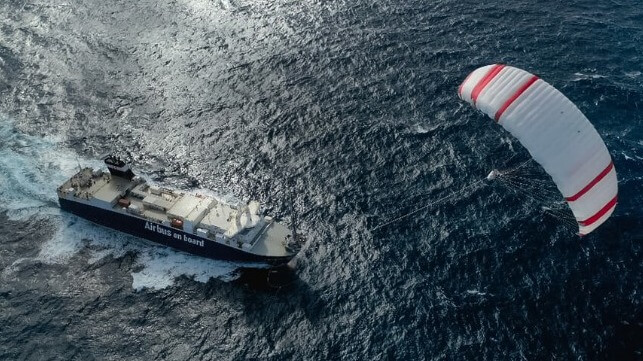Seawing Kite Achieves Traction in Ongoing Sea Trials Aboard Ro-Ro

The French company Airseas, which was created with technologies from the aviation industry’s Airbus, reports it has achieved a key milestone in the testing of its wind propulsion system known as the Seawing. As part of the ongoing sea trials aboard an in-service Ro-Ro, they successfully delivered the first traction from the kite system to the vessel.
The engineers explained that the system for the first time was positioned after earlier flight tests. After lowering it to the correct angle for propulsion, they achieved traction sufficient to provide wind-assisted propulsion to the Ville de Bordeaux, a 5,200 dwt cargo Ro-Ro which is operated by Louis Dreyfus Armateurs and chartered by Airbus. The ship is sailing transatlantic between France and the U.S. Gulf Coast transporting components for Airbus.
Airseas reports the tests show that the system is working as designed. Previously, the company had said their research showed that the Seawing would have a pulling power of up to 100 tons meaning it can contribute to propulsion for a ship of over 200,000 tons and over 1,000 feet in length. They project fuel savings on average of 20 percent by deploying the kite sail.
“We are immensely proud of the technical achievements that we have accomplished so far in our sea trials, and there is more to come,” said Vincent Bernatets, CEO and Co-Founder of Airseas.
The initial installation began in late 2021 after six years of development since having been spun off from Airbus. Testing began in late 2022 with the team having both a 250 m2 version of the wing and a 500 m2 version while the commercial concept calls for a 1000 m2 parafoil, to fly at altitudes of nearly 1,000 feet capturing the stable higher altitude winds to assist vessel propulsion.
During the first tests, they validated the systems including the launch, take-off, ascent, descent, and landing. The system is fully automated. They reported that the Seawing was flying more than 650 feet above sea level. Having demonstrated the ability to generate traction, the tests are now working on the automation system and the flights.

that matters most
Get the latest maritime news delivered to your inbox daily.
The company is also working with Japanese shipping company K-Line, which has announced plans to also begin testing the system this year. K-Line installed the system on one of its bulkers and also reported plans to outfit it on a new vessel next year. K-Line has an initial contract for five vessels and based on the outcomes of the tests has a 20-year agreement that calls for installing the Seawing on 51 vessels.
Airseas reports that it is working to scale up operations including plans for a commercial factory that they expect to open in 2026. Their goal is to have the system broadly commercially available by 2031.
